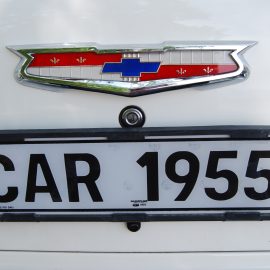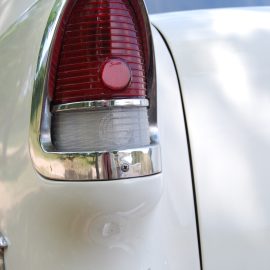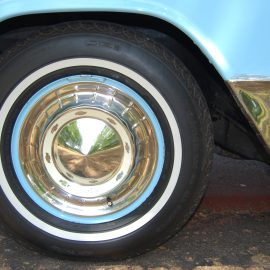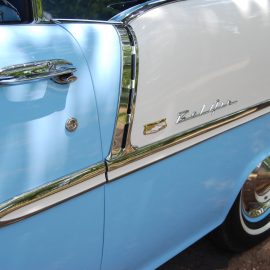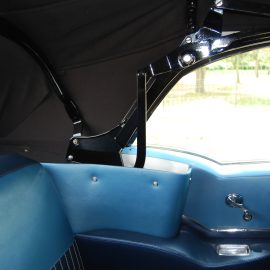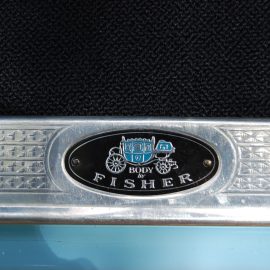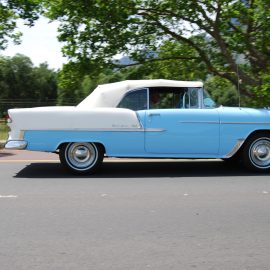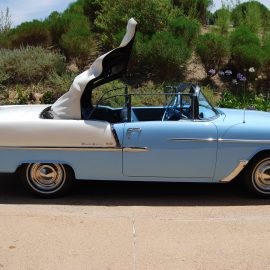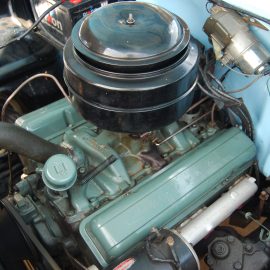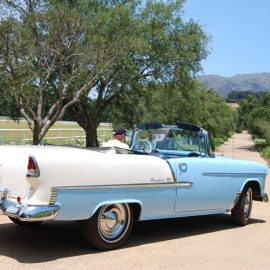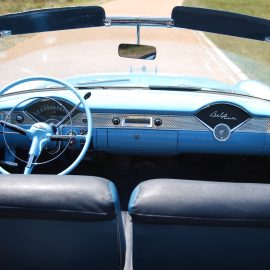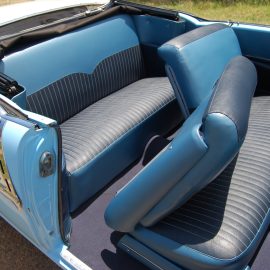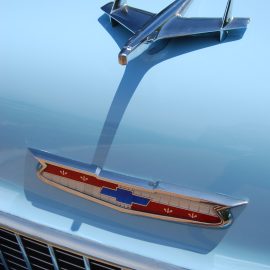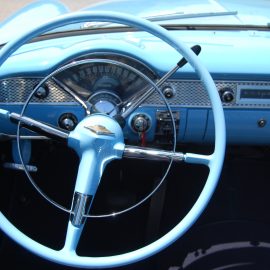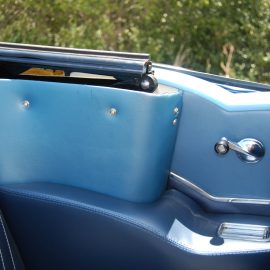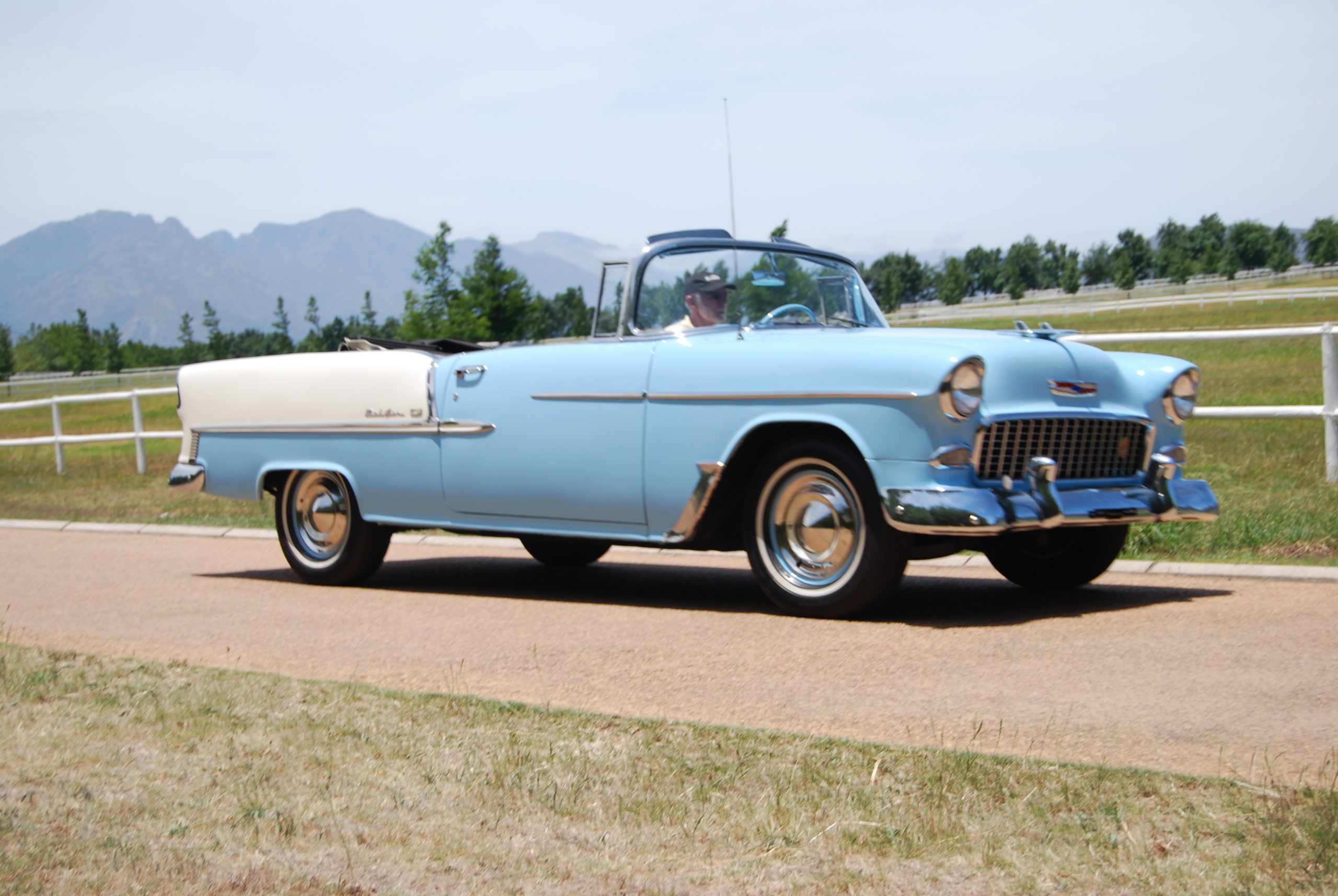
05 Nov Bow-ties and Boulevards
Bel Air – the name alone suggests the good life, an affluent residential area in the hills of the west side of the city of Los Angeles, California. Together with Beverly Hills and Holmby Hills, it forms the Platinum Triangle of Los Angeles neighbourhoods. In the 1950s, together with Ford and Chrysler, General Motors formed part of America’s ‘platinum triangle’ of motor manufacturers and when it came to introducing a truly all-new model to a nation – especially the youth market – revelling in post-war affluence, the ’55 Chevrolet Bel Air was the right car at the right time. The models were a breakthrough in styling, performance and refinement that set the stage for Chevrolet’s starring role in American life for decades.
The ’55 was actually the second-generation Bel Air, the first of which appeared in 1950 and represented Chevrolet’s premium model. Advertised as being “Entirely new through and through”, these cars were, in fact, built on the underpinnings of existing models so the claim was somewhat tongue in cheek. But the scene was set, and when its replacement was launched in 1955 it really was a ‘road to roof’ redesign. One of the new features was a small and lightweight overhead-valve 265ci 4 342 cc V8 engine that went from drawing board to test bench in just 15 weeks. So good was the concept that Chevrolet’s chief engineer Ed Cole commissioned a manufacturing plant and machine tools before the first engine had even been fired up. It was to become one of the automobile world’s greatest engines and the combination of Bel Air and small-block was to herald a renaissance for Chevrolet.
But back to the car itself. Bel Air was Chevrolet’s premium model (over the 150 and 210 derivatives) and six body styles were on offer – two- and four-door saloons, two-door hardtop and convertible plus two-door (called Nomad) and four-door station wagons. A pillarless four-door Sport Sedan joined the line-up the following year. Two in-line sixes were also available, a 3,5-litre and a 3,9-litre Blue Flame. Depending on the model, engines were mated with a three-speed manual, a two-speed Powerglide or a three-speed Turboglide automatic transmission. It sure was a head-turner in any of its many two-tone colour schemes set off with strips of chrome that added sparkle to the design from every angle. Little wonder that the ’55 was soon dubbed the ‘Hot One’.
The styling was crisp and clean and while continuing the first-generation model’s wardrobe of chrome accents, the overall effect is elaborate yet tasteful with only a suggestion of the ‘make it then ’plate it’ excesses of American automobile design – not to mention fins – that were to follow. There was a suggestion that the radiator grille design was inspired by a Ferrari – the 212 perhaps? – but whether true or false it did possess a slightly European look, an aspect that apparently did not meet with universal favour: the following year it was replaced with a full-width design. Another step forward was the wraparound windscreen that in one stroke of the stylist’s pen made the curved screen of the previous model look dated. Chevrolet’s trademark bow-tie emblem appears in the front and rear badging and in small emblems under each tail-light, adjoining the Bel Air script on the body sides, and in a ring around the centre piece of the full wheel covers. And that is not all…
Just looking at this convertible model makes you want to rush to the open road and drive down to the coast with the substantial power-operated roof (release two header-rail levers first) stowed away behind the back seats. Slide onto the two-tone upholstered split-bench front seat – the backrest hinges forward to allow access to the rear – and it feels like sitting in a sun lounge, the expanses of body-colour metal and bright trim making the cabin quite airy. It is less so in the rear, the design of the hood closing-in the rear three-quarters and the folding mechanism impinging on elbow room. But the whole point of a convertible is to drop the top, right?
Switch on the radio, move the column shift into D and go cruisin’. The big steering wheel is hardly sharp-acting – I lost count of how many turns lock-to-lock – but at least it is light. Engine response is easy and strong – the base 265 with its two-barrel carburettor put out 121 kW at 4 400 r/min and a strong 348 N.m of torque at 2 200, which explains why the two-speed Powerglide was a feasible option. A Popular Mechanics road test reported acceleration as being 0-60 mph (0-96 km/h) in 12,9 seconds, and commented on the car’s comfortable ride and good viability. Motor Trend magazine gave the Bel Air top marks for handling. A Power Pack option soon became available that included a four-barrel carb and delivered 134 kW at 4 600 r/min and 352 N.m at 2 800. It did not stop there, as the Corvette-spec high-compression Super Power Pack option that upped peak power to 145 kW at 5 000 could also be specified. Vacuum-assisted 11-inch drum brakes all round provide effective enough stopping power.
No sissy wind deflectors here. Just turn the operating handles and open out the doors’ quarter-lights and let aerodynamics do the rest. My mind conjures up Hollywood-like images of a cloudless blue sky, distant horizons and Chuck Berry singing Maybellene on the car’s radio. Yes, the good life for sure… and it is no less an enjoyable sensation today. The surroundings may be different but travelling around and about the Franschhoek Valley vineyards in the local motor museum’s stunning dual-blue example provides the perfect backdrop to experiencing and enjoying this landmark Chevrolet.
Despite the longer wheelbase, new ball-joint steering and revised springing set-up (dual wishbones/coil springs up front, live axle on leaf springs at the rear), the suspension bangs and crashes a bit over road irregularities but the soft springing and heavy body (around 1 600 kg) combine to cushion occupants from feeling the jolts – the boulevard is its home.
More Chevrolet bow-ties are to be found on the steering wheel boss, radio faceplate, in the quadrant instrument housing and lots of the shape punched out of the bright finishes stretching across the dash. Was this some kind of cunning subliminal promotion of the brand, or what? But the Bel Air deserves to be flashy – it conjures up an era of rock ’n roll, poodle skirts and Bermuda shorts, crew cuts and pony tails, sneakers and penny loafers and when rebels did not yet have causes. The fitment of seatbelts on new cars was being legislated, the first McDonalds was erected and Coca Cola became available in cans.
It appears as though some right-hand drive versions of the 1955-1957 Bel Airs were shipped from Chevrolet’s plant in Oshawa, Canada, to Australia (in CKD form), New Zealand (as SKD) and South Africa. Some 770 955 Bel Airs were manufactured in 1955 so little wonder that Chevrolet could afford annual facelifts – the 1957 model is hero-worshipped today. But it was the ’55 that set the standard for future generations and stands proud as one of the best of Chevrolet’s numerous ground-breaking automobiles. Little wonder then that America went wild for the 1955 Chevrolet Bel Air.
FMM’s striking blue-and-white Bel Air convertible will be on display in Hall C from end November.




